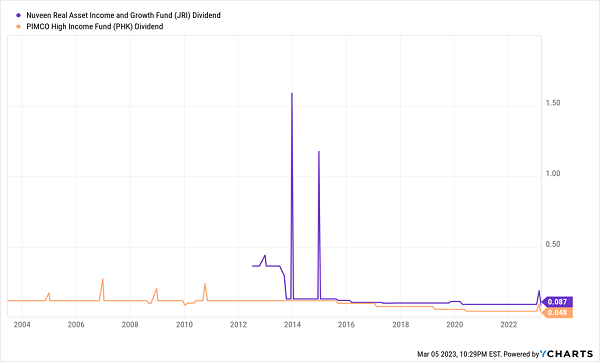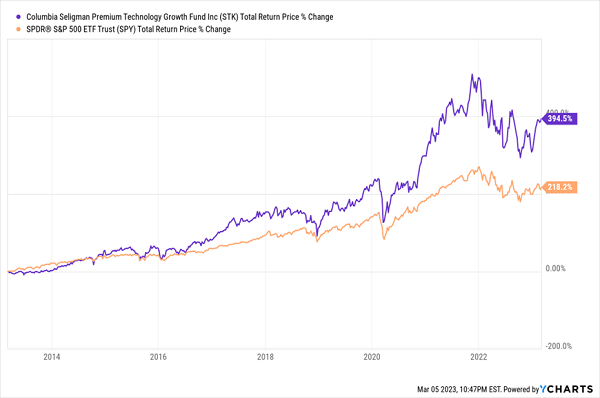Plenty of CEF investors worry about dividend cuts. And for sure, they’re something to keep in mind. But CEFs are not the same as stocks. When we invest in high-quality CEFs, there are a couple other things we need to remember when we catch wind of a cut:
- High-quality CEFs will sometimes reduce payouts by a small amount so they can redeploy capital into oversold bargains. I’ll have more to say on this in a moment, but the upshot is that it holds the potential for us to make more in gains from this move than we lose in dividends.
- As mentioned, these cuts are usually small, reducing the yield only a small amount (again, we’ll demonstrate this below).
Before we go further, we really should stop for a moment and talk about the importance of diversification. Across a portfolio of multiple CEFs, you can ensure your income won’t change much if you choose funds that are profitable, have big discounts to net asset value (NAV, or the investments in their portfolios) and solid fundamentals that will make them profitable over the long term.
Take, for example, two very different funds: the Nuveen Real Asset Income and Growth Fund (JRI), a holding of my CEF Insider service that mainly holds shares of real estate investment trusts (REITs), utilities and pipelines, as well as bonds issued by these firms; and the corporate bond–focused PIMCO High Income Fund (PHK). Both funds have cut dividends in the past:
JRI Reduced Its Payout More Than PHK …
 What we are seeing here is a history of very small payout cuts over time, including a penny-per-share cut most recently introduced by JRI at the start of this year. PHK’s cuts are bigger but seemingly behind it as dividends have stayed stable since early 2020.
What we are seeing here is a history of very small payout cuts over time, including a penny-per-share cut most recently introduced by JRI at the start of this year. PHK’s cuts are bigger but seemingly behind it as dividends have stayed stable since early 2020.
Now look at this.
… But JRI Still Soared (and Crushed Our “Safer” Payer)
 Although PHK’s dividend has been stable for three years, it has earned investors less money. To be sure, JRI’s recent penny-per-share cut does lower distributions a hair, bringing the current yield to 8.7% from 9.6%. But that’s still a very high income stream.
Although PHK’s dividend has been stable for three years, it has earned investors less money. To be sure, JRI’s recent penny-per-share cut does lower distributions a hair, bringing the current yield to 8.7% from 9.6%. But that’s still a very high income stream.
And if you aren’t happy with JRI’s dividend cut from early 2020, you can still sell, then redirect the profits into another CEF with a higher yield. (A good place to start is with the collection of best buys that we publish at the end of every issue of CEF Insider.)
Moreover, JRI’s penny-per-share cut sets it up for further gains because it lets the fund redeploy its capital into REITs, which are particularly oversold now. An eye for value like that is why JRI is still a strong performer. Adding to its appeal is the fact that despite this, it trades at a huge 13.3% discount to NAV—while the poorer-performing PHK sports an 11% premium!
To delve a little deeper into CEF dividend cuts, let’s go back to JRI’s payout reduction in October 2017, when dividends were cut by half a penny per share. This cut was one reason why I recommended JRI to CEF Insider members. Speaking of Nuveen, I wrote in the October 2017 issue that: “The firm will cut dividends if it thinks that’s good for the fund as a whole—and in JRI’s case, it has been.” That was true in October 2017 and it’s still true in 2023.
It’s also true for a lot of closed-end funds. Of the 10 top-performing CEFs of all-time, all 10 have cut dividends at some point in their history, and seven have cut dividends over the last decade.
However, these funds have also outperformed their benchmark index funds over the same period while yielding about five times as much as the S&P 500, thanks to their 8.6% average yield. In short, these funds get you a high income stream that stays high, even after small cuts here and there, as well as market outperformance.
Check out how just one of those superstar CEFs, the Columbia Seligman Premium Technology Growth Fund (STK), has outrun the S&P 500 for a decade.
STK Outruns the Index
 It just goes to show that with CEFs, when you focus on long-term total returns instead of a penny dividend cut here or there, and when you diversify into a collection of top-quality funds with high income streams and market-beating potential, you can create true wealth.
It just goes to show that with CEFs, when you focus on long-term total returns instead of a penny dividend cut here or there, and when you diversify into a collection of top-quality funds with high income streams and market-beating potential, you can create true wealth.
— Michael Foster
Yours Now: My Top 5 CEFs to Buy (for Big 9.1% Dividends and 20%+ Gains) [sponsor]
The key thing to take away here is that buying a top-quality CEF at a discount is the best way to pocket stable payouts and price upside from these often-misunderstood funds.
In fact, if you buy a discounted CEF with a management team that’s also fishing for oversold bargains, you’re giving yourself a “double discount” that’s just not available with any other asset class!
This is the key to building true wealth in CEFs.
And I’m not going to leave you hanging here, because I’ve also uncovered 5 deep-discounted CEFs I see as having the biggest upside (not to mention some of the biggest dividend yields!) of 2023. I’m talking 20% price gains here, to go along with these 5 funds’ rich 9.1% average dividend yields.
I’ve put the details on these 5 wonderful income plays in an insightful Special Report I want to share with you today.
Click here and I’ll reveal my full CEF-investing strategy and show you how to download a copy of this breakthrough report, which contains the names, tickers, current yields and other critical research on these 5 “must-buy” 9.1%-yielding CEFs.
Source: Contrarian Outlook

